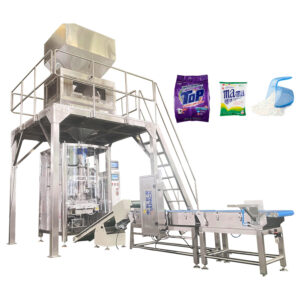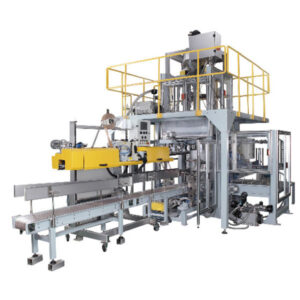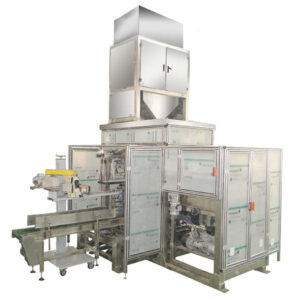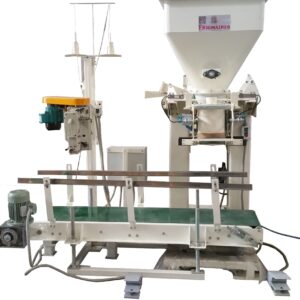Description
| Parameter | Specification |
|---|---|
| Packaging Capacity | 500-2000 kg (adjustable) |
| Bag Type | Big Bag (FIBC) |
| Bag Size | Customizable, typically 1000×1000 mm |
| Weighing Accuracy | ±0.2% |
| Filling Speed | 5-20 bags/hour |
| Power Supply | 220V/380V, 50Hz/60Hz (customizable) |
| Total Power | 4 kW |
| Air Pressure | 0.6-0.8 MPa |
| Air Consumption | 0.6 m³/min |
| Material Contact Parts | Stainless Steel (SS304) |
| Control System | PLC Control System |
| HMI | Touch Screen Interface |
| Operation Mode | Manual/Automatic |
| Dust Collection | Integrated Dust Collector |
| Safety Features | Emergency Stop, Overload Protection |
| Dimension (LxWxH) | Customizable, typically 4000x1500x3500 mm |
| Weight | Approx. 1500 kg |
An Introduction to Big Bag Granular Heavy Bag Packaging Machine
Specialized industrial equipment is used to package large quantities of granulated substances such as rice in the Big Bag Granular Heavy Bag Packaging Machine. These machines have been designed to automate the packaging process by ensuring bags are filled consistently and accurately so that efficiency is optimized and human intervention is reduced.
Processes of packing
The Big Bag Granular Heavy Bag Packaging Machine’s packing process comprises several series of steps, which help ensure efficient and accurate packaging of rice:
Material Feeding: The rice enters the machine through a predetermined inlet, usually a conveyor belt or hopper system.
Weighing and Dispensing: Innovative weighing technology ensures that specific amounts of rice grains are measured for each bag. Thus the use of load cells or weight sensors such as those found in other related machines.
Bag Placement: Empty bags are pre-positioned under the dispensing mechanism in anticipation of filling with measured rice quantity.
Filling: Put simply, rice grains are poured into these bags while observing some degree of control to prevent overfilling or under-filling situations.
Sealing: These bags need to be secured after filling them with contents so that they don’t spill out or get contaminated during transportation and storage. This can be done using heat sealing, stitching, etc., depending on machine design specifics.
Optional Additional Steps: Some machines may also include other features like printing on the bag, labeling it, and even palletizing as an added advantage in facilitating downstream logistics activities thereby enhancing overall productivity during packaging processes.
Applications
The main application areas for Big Bag Granular Heavy Bag Packaging Machines span across various industries mainly engaged in granule materials packaging. Examples may include:
Agriculture– Rice, Grains/ Pulses/Seeds/Fertilizers/Animal feed/Powder Sugar.
Construction– Cement/sand/gravel/construction aggregates.
Chemicals– powder chemicals; i.e. Fertilizers/detergents/pesticides.
Food and Beverages– Sugar/flour, salt, etc. Bulk food ingredients.
Pharmaceuticals– Powdered drugs, pharmaceutical ingredients.
Functions of the machine
This machine helps in efficient packaging by performing several operations:
Weighing: Accurate weighing of granulated materials ensures reliable filling levels as per the defined weights.
Dispensing: Discharge measured quantities of material into bags for optimum packing efficiency and minimal wastage.
Sealing: Ensuring that bags are tightly sealed to maintain product quality by preventing spillage and external contamination.
Monitoring: To be able to detect any deviations or abnormalities, that might arise during this process especially if they go unchecked since it is crucial for solid control and operational reliance on quality.
Integration: Allows for seamless integration of conveyor systems, labeling systems, palletizers, and other upstream-downstream equipment to achieve full automation in a packaging line.
How to Operate
To operate a Big Bag Granular Heavy Bag Packaging Machine, one must be conversant with its controls, settings, and safety protocols. However, specifics may change slightly depending on model or manufacturer; here are general steps that can be followed for normal operations:
Preparation: Make sure that it is correctly set up while adjusting all the calibrations then ensure that you have enough packing stuff (rice grains/bags).
Start-up: Power up your machine so that it begins functioning; also use your control system when checking all security devices are functioning properly if not turn them off where necessary otherwise leave those intact just like before.
Material Loading: Rice grains are placed into the feed hopper or conveyed into this machine’s conveyor system from another source point i.e. trucks.
Settings Adjustment: Change your bag sizes and input fill weights at sealing parameters inside the control panel.
The Functioning: Begin the process of packaging by initiating it via the control interface, thereby allowing the machine to dispense, fill, and seal bags automatically according to the settings that were put in.
Monitoring: Continuously follow up on the packaging process to detect any abnormality or issue arising and take corrective action immediately.
Closure: At the end of a given packaging run, shut off this equipment safely as per the manufacturer’s manual while cleaning and preparing it for use later.
Role
Big Bag Granular Heavy Bag Packaging Machines play several important roles in the packaging industry. These roles include:
Manufacturing: The big bag granular heavy bag packaging machine’s purpose is to offer efficient and scalable solutions for packing large volumes of granules constantly;
Transportation: It would facilitate easy handling, movement and storage of packaged goods hence improving the efficiency as well as effectiveness in supply chain management through reducing associated costs such as overproduction or under-utilization thereof;
Quality assurance: This ensures that products are packed consistently at all times so that there can never be any confusion regarding what needs changing within the production process if something goes wrong along with more consistent speeds throughout manufacturing processes which allow their products to meet these expectations but also have enough room left over against errors made by those working under pressure just like them even when they try their best making sure everything is done right all times without any mistake whatsoever because then every single item would be sold based exclusively upon what customers themselves perceive about how safe those things seem;
Cost savings: Cutting down on labor-intensive tasks helps organizations save money while reducing product waste and improving operational efficiencies.
Innovation: The inclusion of advanced features and automation technologies has led to the development of innovative packaging systems.
Experts say
It is no secret that adopting Big Bag Granular Heavy Bag Packaging Machines has many benefits for firms engaged in bulk packing activities. These advantages include:
Efficiency improvement: Automating this process leads to lower reliance on human resources hence increased throughput.
Measurement accuracy: Advanced weighing and dispensing systems ensure precise filling of sacks with materials thus reducing wastage and ensuring product consistency.
Cost reduction: The firm can reduce labor expenses through automation since machines are more efficient than people at completing repetitive tasks requiring dexterity.
Quality enhancement: When a product comes out sealed properly, its freshness remains unimpaired improving overall quality assurance aspects. This leads to greater customer satisfaction through enhanced safety measures during transportation as well as storage within company premises so that there are fewer chances for mishaps if something goes wrong along with more consistent speeds throughout manufacturing processes which allow their products to meet these expectations but also have enough room left over against errors made by those working under pressure just like them even when they try their best making sure everything is done right all times without any mistake whatsoever because then every single item would be sold based exclusively upon what customers themselves perceive about how safe those things seem;
Productivity: It takes some time before new technology becomes widespread among consumers who don’t know how useful it can be until they see its impact on their daily lives;
Compliance with regulations: Built-in monitoring aids regulatory compliance efforts while traceability tools enable establishing accountability across various levels including national and international regulatory agencies;
What we get from it
The advantages discussed above are not limited to operational efficiency alone, but they also apply to different business facets that determine competitiveness:
Economies of scale: These machines can handle different volumes fulfilling businesses’ requirements accordingly.
Reliable performance: They are tough-looking structures with modern engineering aspects and thus will always perform positively in harsh environments without needing frequent repairs or standby periods.
Product customization: Modularity allows system users to select certain features needed by specific items being packed since some characteristics may differ greatly among various products while others remain constant throughout their entire life cycle due largely where both qualitative information (bounded rationality) affects decision-making abilities more than quantitative data; environmentally-sensitive choices can still have good economic returns; those who do not recycle materials often find themselves having high disposal costs as opposed to those who do so regularly even though these actions might appear very simple initially but eventually turn out quite costly indeed;
Sustainability: Waste reduction and efficient use of materials will help companies achieve their sustainable development goals.
Competitive advantage: This investment enhances productivity, product quality, and operational flexibility, thus making the firm highly competitive.
Questions and Answers
Is it possible to work with different-sized bags and stuff?
Yes, there are several Big Bag Granular Heavy Bag Packaging Machines for processing different types of bags. These machines come with interchangeable parts and adjustable settings.
How precise is the weighing system of this type of equipment?
Its exquisite nature enables these machines to measure whatever is put on them accurately sometimes even in fractions of grams depending on unique technology employed towards achieving such results while at other moments through its weighty provisions which ensure accuracy during weighments without any margin left unaccounted throughout the entire production process unlike conventional scale balances;
Safety features incorporated into these machines Q3?
Care has been taken by manufacturers to include features on machines that make them safe for use hence the safety interlocks, emergency stop buttons, guarding, and overload protection devices.
Is it possible to integrate these machines into existing packaging lines?
Indeed, while this is a fact; Big Bag Granular Heavy Bag Packaging Machines can be integrated with ease into the current packaging lines thus allowing the firms to improve their automation levels as well as effectiveness without causing huge disruptions in doing so.
How do these machines require maintenance?
The main tasks here are cleaning, greasing of moving parts, checking for wear on mechanical components, and calibration of weighing systems for best performance and long life span of the machine.
How energy efficient are these machines?
Most modern packaging equipment saves energy through features like adjustable speed drives used in process control applications, better motors, and automatic stand-by mode that switch off after some time when not in use.
Can these machines be operated remotely or monitored remotely?
Perhaps also there are those models in a higher price range that have remote operation capabilities via embedded control systems and connectivity options (such as Ethernet/ IoT connection).
Are these machines suitable for hazardous locations
It is important to highlight that there may be specific specialized versions designed for operating in such conditions having all required certifications for compliance purposes.
What is the typical lifespan of these machines?
If properly maintained as we have discussed before Big Bag Granular Heavy Bag Packaging Machines could last up to several years or even decades depending on usage and working circumstances.
Can these machines be customized to meet specific packaging requirements?
Certainly, this happens often when producers provide a range of customization alternatives; thereby aligning machine specifications/ features with particular packaging tastes and preferences.





